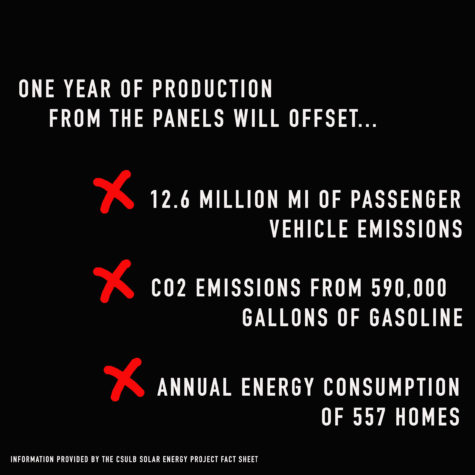Long Beach State is the leader among all of the CSU schools for the number of solar panels on campus.
However, only 15% of the electricity used by Long Beach State’s 323 acre campus is provided by the solar panels located in lots G14 and G7 according to Shawn Cun, energy and utilities manager.
On average, Long Beach State uses 28.5 million kWh per year in electricity. Of this, 7.5 million kWh are provided by the solar panel installments which prevents 1,720 metric tons of carbon dioxide from entering the atmosphere, Cun said.
The solar panels first began producing energy for the campus in 2017. At that time, they were projected to offset the pollution caused by 12.6 million miles of cars driving per year and the carbon dioxide emissions from 590,000 gallons of gasoline according to Solar Energy Project Fact Sheet published in 2017.

Environmental science and policy major Lisa Mouren-Laurens said that the promises made by the school, although lofty, are a good start. However, she also acknowledged the school could be doing more.
“I feel like now is the time to hit the ‘full emergency mode’ button,” Mouren-Laurens said.
She also said that the solar panels are more symbolic than actual contributors to the school’s sustainable energy usage.
Matt James, journalism major, said that the university should be trying harder to use renewable energy sources. He said the low percent of solar energy usage is a way for the university to save face to maintain their message of sustainability.
The sustainability department states on its website that the school does use electricity and natural gas from sources outside of the campus to power and heat the school. Fossil-fuel based sources of energy are generally considered not environmentally friendly, but the department maintains that it is still a cleaner source of energy than coal.
Cun said that when the panels were built, the university signed a “No Export” agreement with Southern California Edison, which means CSULB cannot export excess generation back to the grid. He said that this limited how many solar panels the campus could have.
According to Mouren-Laurens, solar energy cannot be stored for extended periods of time, which may be a reason the school doesn’t use more of it.
Second to car exhaust, electricity remains the school’s second largest green-house gas emissions contributor and the number one expense across the board.
In 2018, the President’s Commission on Sustainability published the “mission of integrating sustainability” for the CSULB. For the 2019-20 school year, the commission hopes to strengthen climate action and adaptation, integrate sustainability into curriculum and engage with the community to further their mission.




